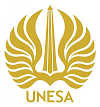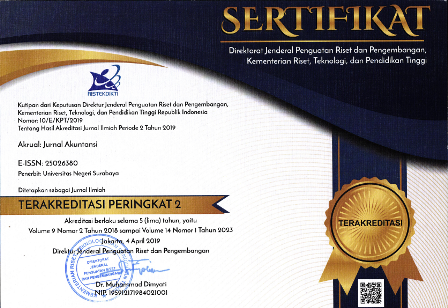Government Expenditure and Human Development in Indonesia
DOI:
https://doi.org/10.26740/jaj.v17n1.p31-49Keywords:
Capital Expenditures; Human Development; Operational Expenditures; Regional EconomyAbstract
Backgrounds: Indonesia experiences economic and human resource inequality. This inequality is caused by several factors, one of which is development that focuses on the island of Java. Apart from that, the Indonesian government has designated 62 disadvantaged areas, all of which are outside the island of Java. Objectives: This research aims to examine and analyze the direct and indirect influence of capital expenditure and operational expenditure on human development in underdeveloped regions in Indonesia through the regional economy as an intervening variable. Therefore, this research focuses on underdeveloped areas in Indonesia from 2011 to 2021. Method: This research is quantitative using the panel regression method with path analysis. The variables used in this research are government spending as an exogenous variable, and human development as an endogenous variable. Results: The results of this research show that capital expenditure has a negative effect on human development, while operational and regional economic expenditure has a positive effect on human development in underdeveloped areas. On the other hand, operational spending has a positive effect on the regional economy, but capital spending has a negative effect on the regional economy of underdeveloped regions. Capital expenditure has a negative impact on the regional economy because government spending so far has not met the needs of regional communities, and its value is still relatively low, inefficiency, and development is still focused on urban areas on the island of Java, so there is a need for more inclusive infrastructure investment.
References
Aït-Sahalia, Y., & Xiu, D. (2019). A Hausman test for the presence of market microstructure noise in high frequency data. Journal of Econometrics, 211(1), 176–205. https://doi.org/10.1016/j.jeconom.2018.12.013
Aksentijević, N. K., Ježić, Z., & Zaninović, P. A. (2021). The effects of information and communication technology (ICT) use on human development—A macroeconomic approach. Economies, 9(3). https://doi.org/10.3390/economies9030128
Aluthge, C., Jibir, A., & Abdu, M. (2021). Impact of Government Expenditure on Economic Growth in Nigeria, 1970-2019. Central Bank of Nigeria Journal of Applied Statistics, 12(1), 139–174. https://doi.org/10.33429/cjas.12121.6/6
Ari, A. R., Wibowo, D., & Rahayu, K. D. (2021). The Influence of Human Development Index Components on Economic Growth in DIY. Proceedings of the 3rd International Conference on Banking, Accounting, Management and Economics (ICOBAME 2020), 169, 213–216. https://doi.org/10.2991/aebmr.k.210311.041
Auwalu, M., Alhassan, D. A. S., & Abdullahi, D. I. O. (2023). Effect Of Disaggregated Government Expenditures On Human Development In Nigeria. African Journal of Accounting and Financial Research, 6(3), 1–21. https://doi.org/10.52589/AJAFR-ZFUVZ5XW
Badan Pusat Statistik. (2023). Berita Resmi Statistik, Pertumbuhan Ekonomi Indonesia Triwulan IV-2022.
Bado, B., Alam, S., Atmaja, V. E., & Saparuddin. (2018). Analysis of welfare in Indonesia. International Journal of Economics and Business Administration, 6(3), 136–145. https://doi.org/10.35808/ijeba/168
Barbier, E. B., & Burgess, J. C. (2020). Sustainability and development after COVID-19. World Development, 135, 105082. https://doi.org/10.1016/j.worlddev.2020.105082
Bosi, S., Camacho, C., & Desmarchelier, D. (2020). Human capital and welfare (halshs-02482543)
Croes, R., Ridderstaat, J., & Shapoval, V. (2020). Extending tourism competitiveness to human development. Annals of Tourism Research, 80(November 2019), 102825. https://doi.org/10.1016/j.annals.2019.102825
Cvetanović, S., Filipović, M., Nikolić, M., & Belović, D. (2015). Endogenous growth theory and regional development policy. Spatium, 1(34), 10–17. https://doi.org/10.2298/SPAT1534010C
Devarajan, S., Swaroop, V., & Zou, H. (1996). Shantayanan Devarajan, Vinaya Swaroop*, Heng-fu Zou. Journal Monetary Economics, 37, 313 344.
Dewi, I. G. A. A. K., & Supadmi, N. L. (2016). Pengaruh Alokasi Belanja Rutin dan Belanja Modal Pada Indeks Pembangunan Manusia. E-Jurnal Akuntansi Universitas Udayana, 14(1), 695–722.
Edeme, R. K., & Nkalu, C. N. (2019). Public expenditure and human development in Nigeria in the last decade, composition and distributional impacts. Economics and Business Letters, 8(2), 62–73. https://doi.org/10.17811/ebl.8.2.2019.62-73
Erizal, J., Supriyono, B., Santoso, B., & Domai, T. (2022). Improving the Indonesian Taxation System using Tax Amnesty’s Policy. WSEAS Transactions on Business and Economics, 19, 876–884. https://doi.org/10.37394/23207.2022.19.76
Gemmell, N., Kneller, R., & Sanz, I. (2016). Does the Composition of Government Expenditure Matter for Long-Run GDP Levels? Oxford Bulletin of Economics and Statistics, 78(4), 522–547. https://doi.org/10.1111/obes.12121
Han, C., & Lee, G. (2022). Bias correction for within-group estimation of panel data models with fixed effects and sample selection. Economics Letters, 220, 110882. https://doi.org/10.1016/j.econlet.2022.110882
Haque, M. I., & Khan, M. R. (2019). Role of oil production and government expenditure in improving human development index: Evidence from Saudi Arabia. International Journal of Energy Economics and Policy, 9(2), 251–256. https://doi.org/10.32479/ijeep.7404
Heriasman. (2020). The Effect Of Economic Growth And Capital Expenditure To Human Development Index (HDI) In Indragiri Hulu District. Jurnal Manajemen Dan Bisnis, 9(2), 208–217
Hill, H. (2021). What’s happened to poverty and inequality in indonesia over half a century? Asian Development Review, 38(1), 68–97. https://doi.org/10.1162/adev_a_00158
Karlinda, E., Rheza, B., Damanik, M. I., Agustine, T. E., & Sianturi, M. N. (2015). Optimalisasi Fiskal bagi Pertumbuhan Ekonomi Daerah: Peran Belanja Operasional dan Belanja Modal dalam APBD.
Khan, R., & Chaudhry, I. S. (2019). Impact of Human Capital on Employment and Economic Growth in Developing Countries. Review of Economics and Development Studies, 5(3), 487–496. https://doi.org/10.26710/reads.v5i3.701
Kuersteiner, G. M. (2019). Invariance principles for dependent processes indexed by Besov classes with an application to a Hausman test for linearity. Journal of Econometrics, 211(1), 243–261. https://doi.org/10.1016/j.jeconom.2018.12.015
Liu, Y., & Zhuang, X. (2023). Shrinkage estimation of semi-parametric spatial autoregressive panel data model with fixed effects. Statistics and Probability Letters, 194, 109746. https://doi.org/10.1016/j.spl.2022.109746
Mathews, A. T. (2022). Human Capital And Social Sector Expenditure. Towards Excellence, 14(3), 571–582. https://doi.org/10.37867/TE140354
Mensah, J. (2019). Sustainable development: Meaning, history, principles, pillars, and implications for human action: Literature review. Cogent Social Sciences, 5(1), 1653531. https://doi.org/10.1080/23311886.2019.1653531
Muhammed, S., Maureen, O. C., & Itodo, I. C. (2023). Government Expenditure on Human Capital Development: Implications for Economic Growth in Nigeria. Journal of Sustainable Development, 4(2), 30–35. https://doi.org/10.5539/jsd.v4n3p72
Nasution, M. (2020). Ketimpangan Antar Wilayah & Hubungannya Dengan Belanja Pemerintah: Studi Di Indonesia. Jurnal Budget, 5(2), 2020
Nguyen, H. H. (2019). The role of state budget expenditure on economic growth: Empirical study in Vietnam. Journal of Asian Finance, Economics and Business, 6(3), 81–89. https://doi.org/10.13106/jafeb.2019.vol6.no3.81
Nyarko-Asomani, A., Bhasin, V. K., & Aglobitse, P. B. (2019). Government capital expenditure, recurrent expenditure and economic growth in Ghana. Ghanaian Journal of Economic, 7(1).
Ogbuagu, A. R. (2019). the Dynamic Correlation Between Fiscal Spending on Education, Health, Consumption and Standard of Living in Nigeria. International Journal of Economics and Financial Issues, 9(3), 259–267. https://doi.org/10.32479/ijefi.8077
Oluwatobi, S. O., & Ogunrinola, O. I. (2011). Government Expenditure on Human Capital Development: Implications for Economic Growth in Nigeria. Journal of Sustainable Development, 4(3), 72–80. https://doi.org/10.5539/jsd.v4n3p72
Omar, D. A. (2020). Inter-relationship between economic development and human development-analytical study of selected Arab countries. Utopia y Praxis Latinoamericana, 25(Extra1), 85–95. https://doi.org/10.5281/zenodo.3766122
An empirical retrospect of the impacts of government expenditures on economic growth: new evidence from the Nigerian economy. Journal of Economic Structures, 9(6), 1–13. https://doi.org/10.1186/s40008-020-0186-7
Oukhallou, Y. (2020). Military Expenditure and Economic Growth : The South American Case. Munich Personal RePEc Archive, 98508, 0–34
Ozdemir, S., Erdogan, S., & Gedikili, A. (2017). Indonesia. In Handbook of Research on Socio-Political Factors Impacting Economic Growth in Islamic Nations. IGI Global. https://doi.org/10.4018/978-1-5225-2939-2.ch017
Paudel, R. C. (2023). Capital expenditure and economic growth: A disaggregated analysis for Nepal. Cogent Economics and Finance, 11(1). https://doi.org/10.1080/23322039.2023.2191449
Peraturan Menteri Keuangan Republik Indonesia (2020).
Putria, A. C., Prakoso, T. S., & Ohyver, M. (2023). Modeling the effect of poverty rate, GDRP, and minimum wage, on mean years of schooling in Gorontalo province with panel data regression. Procedia Computer Science, 216, 510–516. https://doi.org/10.1016/j.procs.2022.12.163
Qamruzzaman, M., Jianguo, W., Jahan, S., & Yingjun, Z. (2020). Financial innovation, human capital development, and economic growth of selected South Asian countries: An application of ARDL approach. International Journal of Finance and Economics, 26(3), 4032–4053. https://doi.org/10.1002/ijfe.2003
Rahmawati, F., & Yuniarti, R. A. (2020). Analysis of the Effect of Industrial Agglomeration , Economic Growth , Human Development Index ( Hdi ), and Open Unemployment Rate on Regional Inequality in East Java Province. South East Asia Journal of Contemporary Business, Economics and Law, 22(1), 1–9.
Ratnasari, V., Hidayatul, S., Tri, A., & Dani, R. (2023). MethodsX Statistical modeling to analyze factors affecting the middle-income trap in Indonesia using panel data regression. MethodsX, 11(July), 102379. https://doi.org/10.1016/j.mex.2023.102379
Regina, T. (2022). Analisis Faktor-Faktor Yang Mempenggaruhi Pertumbuhan Ekonomi Di Indonesia. Kompleksitas: Jurnal Ilmiah Manajemen, Organisasi Dan Bisnis, 11(1), 36–45. https://doi.org/10.56486/kompleksitas.vol11no1.201
Salim, W., & Faoziyah, U. (2019). Perkembangan Daerah Tertinggal Dan Terentaskan Di Indonesia. In Pusat Penelitian Infrastruktur dan Kewilayahan (PPIK) (011219). https://ppiw.itb.ac.id/wp-content/uploads/sites/120/2019/12/03-Perkembangan-Daerah-Tertinggal-.pdf
Sartika, D. (2020). Decentralization and regional autonomy in the industrial revolution 4.0 era. Mulawarman International Conference on Economics and Business, 83–95. http://journal.feb.unmul.ac.id/index.php/MICEBProceeding/article/view/7097
Shenia, D. O., Junita, A., & Meutiac, T. (2021). Pengaruh Pendapatan Asli Daerah, Dana Alokasi Umum, Dan Dana Alokasi Khusus Terhadap Belanja Modal Di Kota langsa. Jurnal Mahasiswa Akuntansi Samudra, 2(2). https://doi.org/10.56076/jkesp.v6i3.2167
Suranta, S., Sulardi, S., & Hananto, S. T. (2020). Human Development Index (HDI): Comparative Study of Western Indonesia and Eastern Indonesia Region. The 1st Internantional Congress on Regional Economic Development. https://conference.feb.uns.ac.id/ocs/index.php/incredible/incredible/paper/view/1528
Susiani, & Rusianti, A. (2022). Pengaruh Pertumbuhan Ekonomi , Pendapatan Asli Daerah ( PAD ) dan Jumlah Penduduk Terhadap Belanja Modal. YUME: Journal of Management, 5(2), 327–341.
Sutopo, B., & Siddi, P. (2018). Capital expenditures and performance of local government administration. Polish Journal of Management Studies, 17(1), 221–231. https://doi.org/10.17512/pjms.2018.17.1.18
Teoldo, I., & Cardoso, F. (2021). Talent map: how demographic rate, human development index and birthdate can be decisive for the identification and development of soccer players in Brazil. Science and Medicine in Football, 5(4), 293–300. https://doi.org/10.1080/24733938.2020.1868559
Tjodi, A. M., Rotinsulu, T. O., & Kawung, G. M. . (2018). Pengaruh Pengeluaran Pemerintah Sektor Pendidikan, Sektor Kesehatan dan Belanja Modal Terhadap Indeks Pembangunan Manusia Melalui Pertumbuhan Ekonomi (studi Di Provinsi Sulawesi Utara. Jurnal Pembanguan Ekonomi Dan Keuangan Daerah, 19(4), 27–44
United Nations Development Programme. (2020). HUMAN DEVELOPMENT PERSPECTIVES COVID-19 AND HUMAN DEVELOPMENT : Assessing the Crisis , Envisioning the Recovery The team that created this report includes Pedro. United Nations Development Programme. http://hdr.undp.org/sites/default/files/covid-19_and_human_development_0.pdf
Waweru, D. (2021). Government Capital Expenditure and Economic Growth: An Empirical Investigation. Asian Journal of Economics, Business and Accounting, January 2021, 29–36. https://doi.org/10.9734/ajeba/2021/v21i830409
Yuanita, D. W., Dewi, C. N., & Setyowati, S. M. (2023). Kinerja dan Investasi Sektor Publik sebagai Bentuk Pelayanan Daerah: Sebuah Telaah Pustaka. Jurnal Ilmiah Akuntansi Dan Keuangan, 21(1), 23–33.
Zebua, W. F., & Adib, N. (2014). Pengaruh Alokasi Belanja Modal, Belanja Barang dan Jasa, Belanja Hibah Dan Belanja Bantuan Sosial Terhadap Kualitas Pembangunan Manusia (Studi Pada Kabupaten dan Kota di Wilayah Provinsi Jawa Barat Tahun 2011-2013). Jurnal Ilmiah Mahasiswa FEB, 3(1), 1–18. https://jimfeb.ub.ac.id/index.php/jimfeb/article/view/1491
Zhang, X., Astivia, O. L. O., Kroc, E., & Zumbo, B. D. (2022). How to think clearly about the central limit theorem. Psychological Methods. https://doi.org/10.1037/met0000448
Downloads
Published
How to Cite
Issue
Section
License
Copyright (c) 2025 Suyanto Suyanto, Jajuk Suprijati, Wiwik Budiarti, Dendy Syahru Ramdhan, Muhammad Afdha Alif Almughni, Muhtar Muhtar, Junaedi Junaedi, Rahmawati Erma Standsyah, Amirul Mustofa, Eny Haryati

This work is licensed under a Creative Commons Attribution-NonCommercial 4.0 International License.
 Abstract views: 169
,
Abstract views: 169
, PDF Downloads: 288
PDF Downloads: 288

















